b. State Key Laboratory of Systematic and Evolutionary Botany and Herbarium, Institute of Botany, Chinese Academy of Sciences, Beijing 100093, China;
c. The Public Service Platform for Industrialization Development Technology of Marine Biological Medicine and Products of the State Oceanic Administration, Fujian Key Laboratory of Special Marine Bioresource Sustainable Utilization, Southern Institute of Oceanography, College of Life Sciences, Fujian Normal University, Fuzhou 350117, China
Neottia Guettard consists of small terrestrial orchids and includes both autotrophic and mycoheterotrophic species. There are approximately 60 species in Neottia widely distributed in northern temperate regions, with a few species extending into alpine areas of Asian subtropical regions (Chen, 1981, 1999; Dressler, 1981; Pearce and Cribb, 2002; Pridgeon et al., 2005; Chen et al., 2009; Raskoti et al., 2012; Jin, 2014; Jin and Pang, 2016; Zhou and Jin, 2018; Govaerts et al., 2019; Mu et al., 2020). Morphologically, Neottia is characterized by resupinate flowers, a more or less curved column, retrorse-inclined anthers, and sectile and naked pollinia.
During our fieldwork in Wuyishan, Fujian, eastern China, we discovered an unknown species of Neottia. Previous specimens, which lacked complete flowers, were identified as Listera puberula Maxim. However, our morphological and molecular analysis indicate that this is a new species.
2. Material and methods 2.1. Morphological descriptionThe morphological description is based on plants growing in situ. Bracts, sepals, petals, the lip, column and seeds were examined under stereoscopic zoom microscope (Axio zoom. v.16, ZEISS, Germany) and measured with a digital caliper. Habitats and phenology of the new species are based on field observations. Plants were collected from Wuyishan Mountains, Wuyishan City, Fujian, China.
2.2. Molecular systematicsWe used the Plant Genomic DNA Kit (Beijing Biomed Co., LTD, Beijing, China) to isolate total genomic DNA from silica-gel-dried materials. Three markers (plastid matK and rbcL; nrITS) were used to infer the phylogenetic position of Neottia wuyishanensis. PCR and sequencing primers for matK, rbcL and nrITS followed Zhou and Jin (2018). The sequences ofN. wuyishanensis were added to each corresponding data matrix from Zhou and Jin (2018). In total, 66 members fromNeottia, Cephalanthera, Aphyllorchis, Epipactis and Holopogon were included in our analysis (Table S1). Three species of Ophrys and Serapias were used as outgroup (Table S1). Each individual sequence was aligned using MAFFT 7.310 (Katoh and Standley, 2013) with default settings. A concatenated supermatrix of the three sequences was generated using PhyloSuite v.1.1.15 (Zhang et al., 2018) for the phylogenetic analysis. All missing data were treated as gaps. Gblocks 0.91b (Castresana, 2000) was applied to eliminate poorly aligned regions of the concatenated supermatrix with gaps set as no different than other positions. The best nucleotide substitution model according to Bayesian Information Criterion (BIC) was GTR + F + G4, which was selected by ModelFinder (Kalyaanamoorthy et al., 2017) implemented in IQ-TREE v.1.6.8. Bayesian Inference (BI) were inferred using MrBayes 3.2.6 (Ronquist et al., 2012) under GTR + G + F model (2 parallel runs, 2, 000, 000 generations), in which the initial 25% of sampled data were discarded as burn-in. Phylograms were visualized in iTOL v.5 (Letunic and Bork, 2021).
3. Results 3.1. Molecular phylogeneticsPhylograms from Bayesian Inference (BI) and maximum likelihood (ML) agree with each other. Our analysis indicates thatNeottia wuyishanensis is sister to Neottia fugongensis with middle support (PP = 0.94; BP = 99) (Fig. 1). These two species nested within the species group formed by alpine species from Pan-Himalayan regions, including Neottia divaricata, N. nujiangensis, N. bicalla and N. karoana with medium support (PP = 0.72; BP = 86).
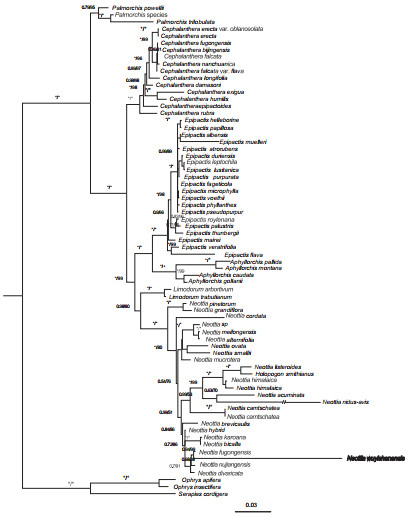
|
| Fig. 1 Phylogram of Neottieae based on Bayesian Inference of nrITS, rbcL and matK. Numbers above branch, posterior probabilities (PP)/bootstrap support (BP). *, BS = 100 or PP = 1.00. |
Neottia wuyishanensis B.H. Chen & X.H. Jin, sp. nov. (Fig. 2, Fig. 3).
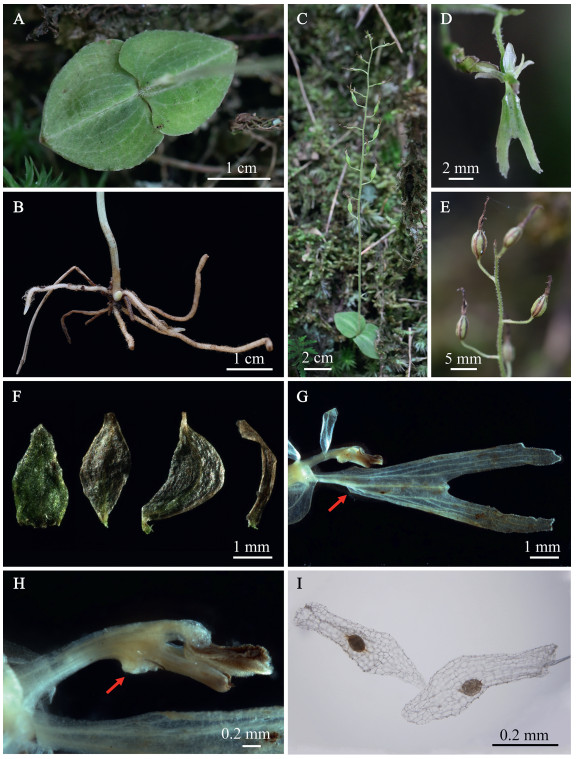
|
| Fig. 2 Neottia wuyishanensis B.H. Chen & X.H. Jin, sp. nov. Photographed by B.H. Chen. (A) Leaves; (B) Roots; (C) Habit; (D) Flower; (E) Mature fruits; (F) Bract, dorsal sepal, lateral sepal, petal; (G) Lip, claw with a pair of auricles (indicated by arrow); (H) Gynostemium, enlarged at apex (indicated by arrow); (I) Seeds. |
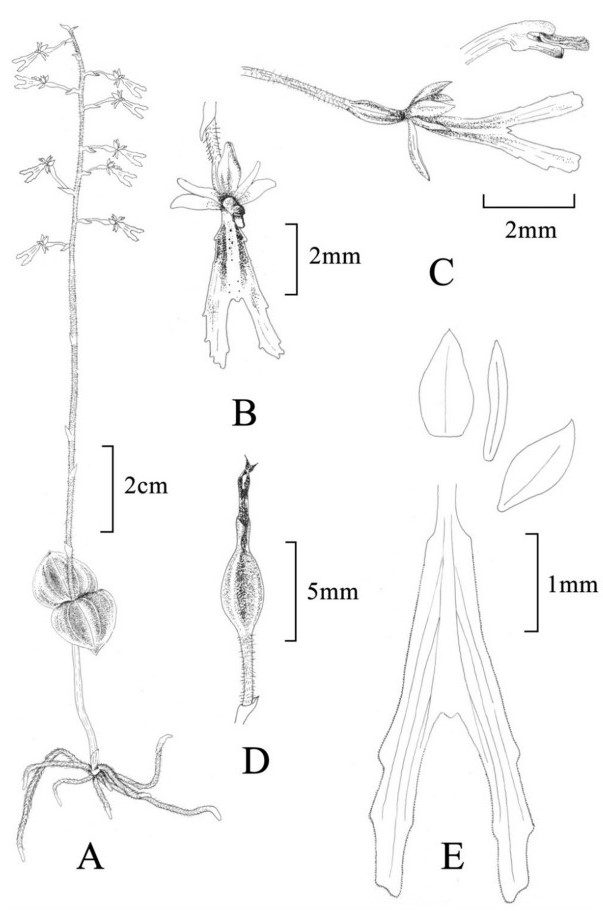
|
| Fig. 3 Illustration of Neottia wuyishanensis B.H. Chen & X.H. Jin, sp. nov. Drawn by D. L. Cai. (A) Habit; (B) Overview of flower; (C) Lateral view of flowers and front view of column; (D) Fruit; (E) Dorsal sepal, petal, lateral sepal and lip. |
Type-China. Fujian: Wuyishan City, Wuyishan Mountains, mixed forest of conifer tree and evergreen broadleaf tree of Fagaceae, 117°45'E, 27°50'N, 1831 m, 29 July 2020, B.H. Chen 04012 (Holotype, FNU!, barcode FNU0040736; isotypes FNU!, Barcode FNU0039789).
Diagnosis-Neottia wuyishanensis is morphologically similar to N. fugongensis (Fig. 4) and N. pseudonipponica (Table 1), but differs from them by having a Y-shaped lip 7.0-9.0 mm long, auricles indistinct into teeth at the base, and lanceolate to oblong lobelets 3.7-4.4 mm long and 0.8-1.1 mm wide.
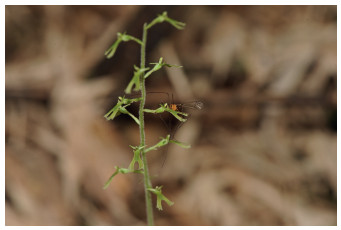
|
| Fig. 4 Close-up of flowers of Neottia fugongensis and its visitor. Photographed by Xiaohua Jin in Fugong County, Yunnan, China, elevation about 3300 m. |
| N.wuyishanensis | N.fugongensis | N.pseudonipponica | |
| Lip | Y-shaped, 7.8-9mm long; auricles indistinct | Y-shaped, 8-9mm long; auricles 1.5mm long, | Y-shaped, 8.5-9mm long; auricles ca. 0.5mm long |
| Lobelets | 3.7-4.4mm long, 0.8-1.1mm wide | 5mm long, 3mm wide | 4mm long, 2.5mm wide |
Description-Terrestrial. Plants 18.5-28 cm long, slender, usually with one white sheath at base. Roots elongate and filiform. Leaves 2, opposite, borne in one fourth to half of plant, broadly ovate, ca. 1.8-1.9 cm long, 1.7-1.9 cm wide, apex acute. Peduncle pubescent, ca. 5 cm long, with 5 bracts; rachis 4-9 cm long, laxly 5-19-flowered; floral bracts ovate-lanceolate, 3-4 mm long, 1.6 mm wide, apex acute to acuminate. Flowers resupinate, whitish green; pedicel 4-6 mm long, pubescent; ovary 2.7-3.0 mm long, glabrous; sepals and petals spreading widely. Dorsal sepal elliptic to oblong, 1-veined, 2.6 mm long, 1.2 mm wide; lateral sepals slightly oblique, lanceolate, ca. 2.8 mm long, 1.3 mm wide, apex obtuse; petals linear to narrowly oblong, 2.2 mm long, 0.5 mm wide; lip Y-shaped, bilobed at apex to the middle of lip, clawed at base, 7.8-9.0 mm long, 1.6-2.7 mm wide at middle, disk with a thickened central ridge extending from base to the sinus with small tooth between lobes; auricles indistinct into teeth at base, approximately 0.3 mm long; lobelets lanceolate to oblong, 3.7-4.4 mm long, 0.8-1.1 mm wide, apex obtuse, margins sparsely dentate and ciliate. Column arcuate, 1.7-1.9 mm long, anther inclined toward rostellum, apex with dilated hood; rostellum spreading forward.
Distribution and habitat-Neottia wuyishanensis grows under Oligostachyum oedogonatum (Z.P. Wang et G.H. Ye) Q.F. Zhang et K.F. Huang (Poaceae), on the edge of mixed forest of Tsuga chinensis (Franch.) E. Pritz (Pinaceae) and Cyclobalanopsis multinervis Cheng et T. Hong (Fagaceae) at an elevation of approximately 1831 m. Pogonatum inflexum (Lindb.) Sande Lac. (Polytrichaceae), Leucobryum juniperoideum Müll. Hal. (Leucobryaceae) and other mosses were found growing together with this new species. Many other plants grow in the surrounding habitat, whose tree layer includes Stewartia sinensis Rehd. et E.H. Wilson (Theaceae), Illicium jiadifengpi B.N. Chang (Schisandraceae), Lindera obtusiloba Bl. (Lauraceae), Euonymus hamiltonianus Wall. (Celastraceae) and others; the shrub layer includes Eurya saxicola H.T. Chang (Pentaphylacaceae), Euonymus euscaphis Hand.-Mazz. (Celastraceae), Hydrangea chinensis Maxim. (Hydrangeaceae), Clethra delavayi Franch. and more; the vegetation layer includes Pentarhizidium orientale (Hook.) Hyata. (Onocleaceae), Huperzia chinensis (Christ) Ching (Lycopodiaceae), Viola davidii Franch. (Violaceae), Swertia bimaculata (Sieb. et Zucc.) Hook. f. et Thoms. ex C.B. Clarke (Gentianaceae), Hemiphragma heterophyllum Wall. (Plantaginaceae), Arisaema erubescens (Wall.) Schott (Araceae), Carex mollicula Boott (Cyperaceae), Liriope spicata (Thunb.) Lour. (Asparagaceae), Neottianthe cucullata (L.) Schltr. (Orchidaceae) and others.
Conservation status-Our fieldwork has discovered only one population of approximately 100 individuals of this species in Wuyishan National Park (713 km2). For the time being, the population is far from any direct threats; therefore, this new species is here preliminarily considered as a status of Least Concern (LC) according to IUCN Red List Categories and Criteria (IUCN Standards and Petitions Subcommittee 2019).
Relationships-Neottia wuyishanensis is closely related to N. fugongensis and N. pseudonipponica by sharing pubescent inflorescence, a long pedicel and ovary of flower, a Y-shaped lip, and gynostemium structure. All three species have a dilated hood on the apex of the column, and the stigma area is especially enlarged (Jin and Li, 2007; Chen et al., 2009; Lin, 2019). However, it is readily distinguished from these species by the auricles at the base of lip, and the shape and size of lobelets of lip (Table 1). N. wuyishanensis readily differs from N. puberula (= Listea puberula) by having a Y-shaped lip with a pair of auricles at the base (versus elliptic lip without auricles), and ciliate lip margins (versus entire).
Phenology-Flowering from July to August; fruits from August to September.
Chinese name-Wǔ Yí Shān Dùi Yè Lán (武夷山对叶兰).
Additional specimens examined-CHINA. Nanping: Chongan County, Wuyi Mountain, elev. 1770 m, 11 August 1964, Wuyi Mountain Expedition team 400617 (PE 00522617).
4. NoteThe name 'Neottia himalaica X.H. Jin' has been proposed for an undescribed entity from Zayu, Xizang. Both morphological characters and molecular systematics indicate that N. himalaica is a distinctive species (Fig. 1, Fig. 5, Fig. 6). However, the only known population, which had approximately 30 individuals, was completely destroyed due to road construction about five years ago. To date, there are only two collections kept in PE. Thus, we retain N. himalaica as an unresolved name until further field observation can confirm its taxonomic status.
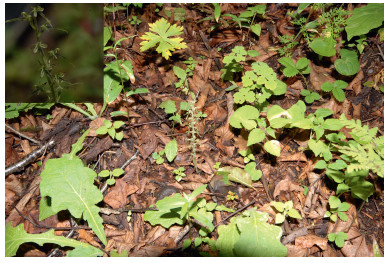
|
| Fig. 5 Plants of Neottia himalaica. Photographed by Xiaohua Jin in Sangjiu village, Zuwagen, Zayu, Xizang, China, elevation about 3400 m. |
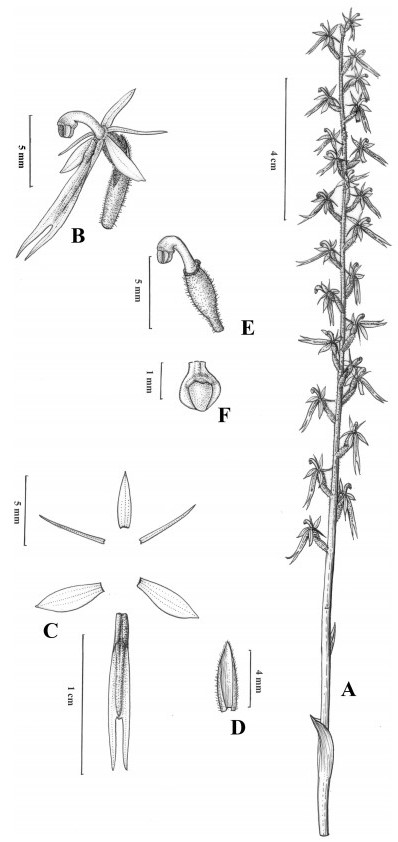
|
| Fig. 6 Illustration ofNeottia himalaica. Drawn by Yuxi Zhu. (A) Plant; (B) Overview of flower; (C) Dorsal sepal, petals, lateral sepals and lip; (D) Floral bract; (E) Lateral view of column; (F) Overview of anther cap. |
BHC discovered and identified the species, performed the experiments and analyzed the data, wrote the manuscript. XHJ revised the manuscript.
Declaration of competing interestThe authors declare no conflict of interest.
AcknowledgementsWe are grateful to Ms. D.L. Cai for the illustration and Mr. Z.K. Xu for his kind help during our fieldwork. This work was financially supported by Project of Orchid Biodiversity Survey of China, National Forestry and Grassland Administration (Grant No. 2020-07), the Sub-project Ⅵ of National Program on Key Basic Research Project (973 Program) (Grant No. 2015FY110200) and the National Special Fund for Chinese Medicine Resources Research in the Public Interest of China (Grant No. 2019-39).
Appendix A. Supplementary dataSupplementary data to this article can be found online at https://doi.org/10.1016/j.pld.2021.01.008.
Castresana J., 2000. Selection of conserved blocks from multiple alignments for their use in phylogenetic analysis. Mol. Biol. Evol, 17: 540-552. DOI:10.1093/oxfordjournals.molbev.a026334 |
Chen S.C., 1981. Three new species of Listera (Orchidaceae) from China. Kew Bull, 35: 759-761. |
Chen, S.C., 1999. Neottia and Listera. In: Lang, K.Y. (Ed. ), Flora Republicae Popularis Sinicae, 17. Science Press, Beijing, pp. 97-121.
|
Chen, S.C., Gale, S.W., Cribb, P.J., 2009. Neottia. In: Wu, Z.Y., Raven, P.H., Hong, D.Y. (Eds. ), Flora of China, vol. 25. Sciences Press, Beijing, in association with Missouri Botanical Garden Press, St. Louis, pp. 184-195.
|
Dressler, R.L., 1981. The Orchids. Natural History and Classification. Harvard University Press, Cambridge, Massachusetts, pp. 1-332.
|
Govaerts, R., Bernet, P., Kratochvil, K., et al., 2019. World Checklist of Orchidaceae. Facilitated by the Royal Botanic Gardens. Published on the Internet, Kew. http://www.iucnredlist.org/documents/RedListGuidelines.pdf. (Accessed 2 October 2019).
|
IUCN Standards, Petitions Subcommittee, 2019. Guidelines for Using the IUCN Red List Categories and Criteria. Version 13. Prepared by the Standards and Petitions Subcommittee. Available from: _aaaaaa_paichu__. (Accessed 28 May 2020).
|
Jin X.H., Li H., 2007. Listera fugongensis (Orchidaceae), a new species from Yunnan. China. Brittonia, 59: 243-244. DOI:10.1663/0007-196X(2007)59[243:LFOANS]2.0.CO;2 |
Jin X.H., 2014. A new species of Neottia (Orchidaceae, Epidendroideae) from southwestern China. Phytotaxa, 177: 188-190. DOI:10.11646/phytotaxa.177.3.8 |
Jin X.H., Pang H.B., 2016. A new species of Neottia (Orchidaceae, Epidendroideae) from alpine border region between China and Myanmar. Phytotaxa, 289: 291-295. DOI:10.11646/phytotaxa.289.3.10 |
Kalyaanamoorthy S., Minh B.Q., Wong T.K.F., et al, 2017. ModelFinder: fast model selection for accurate phylogenetic estimates. Nat. Method, 14: 587-589. DOI:10.1038/nmeth.4285 |
Katoh K., Standley D.M., 2013. MAFFT multiple sequence alignment software version 7:improvements in performance and usability. Mol. Biol. Evol, 30: 772-780. DOI:10.1093/molbev/mst010 |
Lin, Z.P., 2019. The Orchid Flora of Taiwan, a Collection of Line Drawings. National Taiwan University Press, Taibei, pp. 669-681.
|
Mu A.T., Mung H.A., Jin X.H., 2020. Neottia nyinyikyawii (Orchidaceae: Epidendroideae), a new species from Chin State, Myanmar. Phytotaxa, 446: 205-208. DOI:10.11646/phytotaxa.446.3.5 |
Pearce N.R., Cribb P.J., 2002. The Orchids of Bhutan. Royal Botanic Garden Edinburgh & Royal Government of Bhutan. |
Pridgeon, A.M., Cribb, P.J., Chase, M.W., et al., 2005. Genera Orchidacearum, 4. Oxford University Press, Oxford, p. 672.
|
Raskoti B.B., Wood J.J., Ale R., 2012. Neottia chandrae sp. nov. (Orchidaceae) from Nepal. Nord. J. Bot, 30: 187-189. DOI:10.1111/j.1756-1051.2011.01378.x |
Ronquist F., Teslenko M., van der Mark P., et al, 2012. MrBayes 3. 2: efficient Bayesian phylogenetic inference and model choice across a large model space. Syst. Biol, 61: 539-542. DOI:10.1093/sysbio/sys029 |
Zhang D., Gao F., Li W.X., et al, 2018. PhyloSuite: an integrated and scalable desktop platform for streamlined molecular sequence data management and evolutionary phylogenetics studies. BioRxiv: 489088. |
Zhou T., Jin X.H., 2018. Molecular systematics and the evolution of mycoheterotrophy of tribe Neottieae (Orchidaceae, Epidendroideae). PhytoKeys, 94: 39-49. DOI:10.3897/phytokeys.94.21346 |




